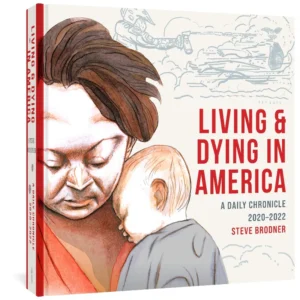
Courtesy Fantagraphics Books
Steve Brodner’s Living & Dying in America: A Daily Chronicle, 2020-2022, is a fascinating and unusual graphic memoir. In the book’s 476 pages, Brodner has captured the feel of the first two Covid years by drawing one image every evening from that day. These range from biographies of people lost due to bad policy or personal choices in the pandemic, to tumultuous events in the day’s news, to political decisions made by our leaders.
Brodner has a daily column in The Nation, where these images were first published, and has contributed for years to other major publications, such as the New York Times Book Review, Sports Illustrated, Playboy, Esquire, Harpers, and the Village Voice.
The images in this book are sometimes quick sketches, sometimes more elaborately rendered, with or without color, or in mixed media. There are political caricatures and realistic portraits; generally Brodner matches his varying styles to the moral quality of the person he is portraying.
“Every day, late at night or early in the morning, from March 26, 2020 to January 1, 2022, the political cartoonist and illustrator Steve Brodner would get to work,” his publisher, Fantagraphics Books, says. “In those midnight hours, he would review the day’s reportage, sit down at his drawing board, and memorialize a singular person or event that played a role, willingly or unwillingly, in shaping that day.”
On the page for May 20, 2020, for example, there is a line drawing of the profile of a National Guardsman in a mask, carrying a cardboard box. The caption reads, “June 24, Trump decreed, will be the end of National Guard deployment because one day longer would have made them eligible for benefits under the GI Bill. They have been aiding vulnerable populations but will not be deployed in the depth of the pandemic in order to screw them and their families. Thank you for your service.” (56)
The effect of all this captured chronology and misery is intense and makes the book feel very personal, which makes it vital to our understanding of what has happened in recent years, beyond the data that 1.06 million Americans have died so far in the pandemic. All readers are likely to recognize something that has affected them; the portrait of a mother and baby on the dust jacket cover was, I was convinced, a Native American woman I know, but when I found the image inside the book, it was not her. You might even find yourself in there; one image is of an indistinct man with an assault rifle, a mask (not for Covid), and a bright yellow topknot, who attended a protest in Minneapolis in May 2020 (66). Who was that guy? Not knowing is a large part of the masked trauma of our lives.
Kurt Vonnegut is attributed with saying, “You meet saints everywhere. They can be anywhere. They are people behaving decently in an indecent society.” There are many such saints in Living & Dying in America, along with a rogue’s gallery of ordinary or powerful people doing very bad things. Let us never forget.
